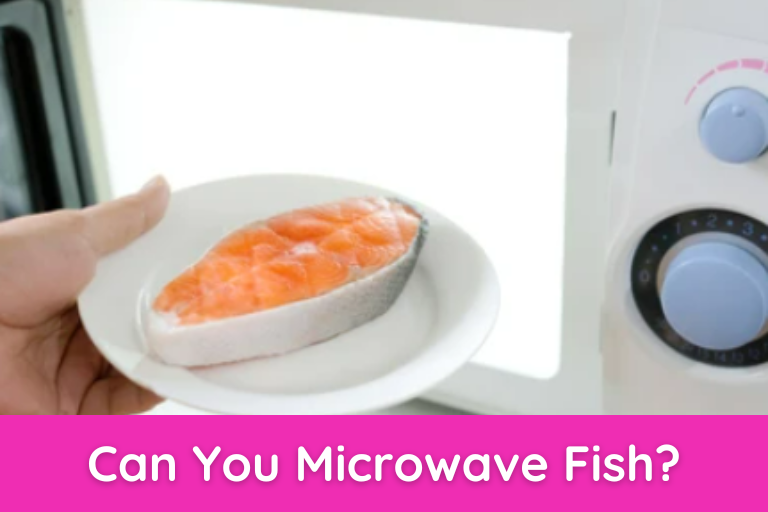Microwaving fish has long been a topic of debate among home cooks. The thought of heating up fish in a microwave often raises concerns about potential issues like uneven cooking, unpleasant odors, and altered texture.
In this blog post, we will delve into the question of whether or not you can microwave fish and explore the factors to consider, pros and cons, and best practices for achieving delicious results.
Understanding Microwaves and Fish:
To understand the interaction between microwaves and fish, let’s first grasp the basics of how microwaves work. Microwaves emit electromagnetic waves that excite water molecules within food, generating heat and cooking the food.
Fish, being a moisture-rich protein, reacts to microwave radiation differently than other ingredients. The water content in fish can lead to a faster cooking process, but it also makes it susceptible to overcooking and uneven heating.
Factors to Consider:
Several factors come into play when deciding whether to microwave fish. The type of fish and its texture play a significant role in determining the outcome. Delicate and flaky fish varieties may require extra caution, as they can easily become dry or fall apart when exposed to high heat. The freshness of the fish is also essential, as fresher fish tends to yield better results.
Additionally, the preparation and seasoning of the fish can influence the microwave cooking process, so it’s crucial to consider these factors as well. Lastly, choosing the right container and covering options can help prevent splatters and ensure even cooking.
Can You Microwave Fish?
Yes, you can microwave fish, but it’s important to follow proper guidelines to ensure even cooking and avoid overcooking or drying out the fish. Here’s a simple method to microwave fish:
- Choose a microwave-safe dish with a lid or use microwave-safe plastic wrap to cover the dish.
- Place the fish in the dish and add a small amount of liquid (water, broth, or white wine) to help steam the fish. You can also add seasonings, herbs, or lemon slices for added flavor.
- Cover the dish with the lid or plastic wrap. If using plastic wrap, make sure to leave a small opening for steam to escape.
- Microwave the fish on medium power (50%) for 3-5 minutes per half-pound of fish, checking for doneness every minute. The cooking time will vary depending on the thickness and type of fish.
- When the fish is cooked through and flakes easily with a fork, carefully remove it from the microwave, as the dish and steam will be hot. Allow the fish to rest for a minute or two before serving.
Keep in mind that microwaving fish can produce a strong odor, so ensure proper ventilation in your kitchen while cooking.
Pros and Cons of Microwaving Fish:
Microwaving fish offers certain advantages. Firstly, it is incredibly convenient and time-saving. With just a few minutes in the microwave, you can have a perfectly cooked fish dish ready to enjoy.
Additionally, microwaving fish helps retain its moisture and nutrients, making it a healthier option compared to other cooking methods that may involve more oil or excessive heat.
However, there are also potential drawbacks to microwaving fish. Overcooking or uneven cooking can be a common issue, resulting in a rubbery or dry texture.
Moreover, the strong odor that often accompanies microwaved fish can be off-putting, especially if you live in close quarters or have sensitive noses around.
Tips for Microwaving Fish:
To achieve the best results when microwaving fish, consider the following tips. Firstly, choose fish varieties that are suitable for microwave cooking, such as salmon, cod, or tilapia. These fish tend to hold up better during the microwaving process. Properly preparing the fish by seasoning it with marinades or herbs can enhance its flavor.
When microwaving, it’s essential to select appropriate cooking times and power levels. Opting for lower power settings and shorter cooking durations can help mitigate the risk of overcooking. Additionally, using microwave-safe containers and covering the fish to trap steam can promote even cooking and reduce splattering.
Alternative Cooking Methods:
If you’re hesitant about microwaving fish, there are alternative cooking methods to consider. Oven-baking fish allows for more control over the cooking process and can yield crispy exteriors and moist interiors. Pan-frying or grilling fish can provide a flavorful and caramelized finish, albeit with more time and effort.
Steaming fish in a stovetop steamer or using microwave-specific steamer bags is another option worth exploring. Comparing these alternatives to microwaving fish can help you determine which method suits your preferences and culinary goals.
Personal Experiences and Expert Opinions:
To gain further insights into microwaving fish, let’s hear from individuals who have tried it themselves. Many home cooks have successfully microwaved fish dishes, reporting quick and satisfactory results.
However, it’s essential to note that personal preferences and experiences can vary. To provide a well-rounded perspective, consulting professional chefs or culinary experts can be beneficial. Their guidance and tips can help refine your microwave fish cooking skills and ensure optimal outcomes.
FAQ:
1. Is it OK to microwave fish?
Yes, it is generally okay to microwave fish. However, there are some factors to consider, such as the type of fish, freshness, and proper cooking techniques, to ensure the best results.
2. How long do you microwave fish for?
The cooking time for microwaving fish can vary depending on the type of fish, thickness, and desired doneness. As a general guideline, start with microwaving for 2-3 minutes on medium power and then check for doneness. Adjust the time accordingly until the fish is cooked through.
3. Can you fry fish in the microwave?
No, frying fish in the microwave is not recommended. The microwave is not designed for frying and may not provide the desired crispy texture. It is best to use traditional frying methods like stovetop frying or deep frying for that purpose.
4. Can I microwave frozen fish?
Yes, you can microwave frozen fish, but it may require adjustments to the cooking time. Follow the instructions on the packaging or increase the cooking time by a few minutes to ensure thorough cooking.
5. How to cook fish in the microwave?
To cook fish in the microwave, place the fish in a microwave-safe dish and cover it loosely with a microwave-safe lid or plastic wrap. Cook the fish on medium power, rotating or flipping it halfway through the cooking process. Use a fork to test for doneness by ensuring the fish flakes easily.
6. Is it safe to reheat fish?
Yes, it is safe to reheat fish. However, take care not to overcook it, as reheating for too long can lead to a dry and rubbery texture. It’s best to reheat fish gently and for a shorter duration to retain its moisture.
7. Is there a way to microwave fish without smell?
While it’s challenging to completely eliminate the smell of microwaved fish, there are a few methods to minimize it. One approach is to add a slice of lemon or a few drops of lemon juice to the dish before microwaving. Another option is to place a bowl of vinegar or a mixture of water and vinegar in the microwave while cooking fish to help neutralize odors.
8. Is it better to reheat fish in the oven or microwave?
Reheating fish in the oven is generally preferred over the microwave if you want to retain its texture and avoid potential sogginess. The oven allows for more even heating and can help crisp up the exterior. However, the microwave is more convenient and faster for reheating small portions of fish.
9. Is microwaving salmon safe?
Yes, microwaving salmon is safe as long as it is cooked properly. Follow the guidelines for microwaving fish mentioned earlier, adjusting the cooking time according to the thickness of the salmon. It’s essential to avoid overcooking salmon to prevent it from drying out.
10. Can you cook chicken in the microwave?
Yes, you can cook chicken in the microwave. However, chicken is best cooked in the microwave when it is cut into smaller pieces or strips to ensure even cooking. It’s important to follow proper cooking times and power levels to avoid undercooking or drying out the chicken.
11. How to fry fish without oil?
Frying fish without oil is possible by using alternative cooking methods like baking, grilling, or broiling. These methods require less oil or even no oil at all, resulting in healthier and less greasy fish dishes. You can use marinades, spices, or a light coating of breadcrumbs to enhance the flavor and texture.
12. Can you boil fish in milk?
Yes, boiling fish in milk is a cooking technique known as “poaching.” Poaching fish in milk can help retain moisture and impart a creamy flavor.
To do this, place the fish in a pan, cover it with milk, and gently simmer until the fish is cooked through. Seasonings like herbs, spices, or lemon can be added to enhance the flavor.
Conclusion:
In conclusion, the answer to the question, “Can you microwave fish?” is yes, but with certain considerations and best practices. Microwaving fish can be convenient, time-saving, and a healthy cooking option. By understanding the interaction between microwaves and fish, considering the type of fish, and following recommended techniques, you can achieve delicious results.
However, if you prefer alternative cooking methods or have specific concerns, exploring oven-baking, pan-frying, or steaming fish may be more suitable. Ultimately, experimenting and finding what works best for you and your taste preferences is the key to enjoying perfectly cooked fish dishes.




